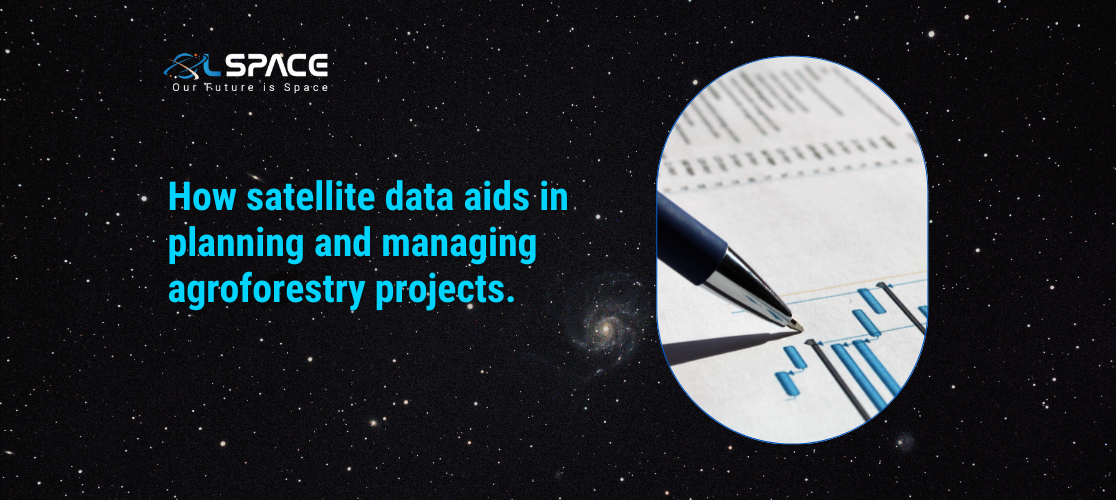02 January 2024
How satellite data aids in planning and managing agroforestry projects.

Agroforestry, the integration of trees and shrubs into agricultural landscapes, offers a sustainable approach to land management that combines the benefits of forestry and agriculture. Leveraging satellite data plays a crucial role in planning and managing agroforestry projects by providing valuable insights, monitoring land conditions, and facilitating informed decision-making. This article explores how satellite data aids in the planning and sustainable management of agroforestry projects.
1. Site Selection and Planning:
Land Cover and Vegetation Mapping: Satellite data assists in mapping existing land cover and vegetation types, helping planners identify suitable areas for agroforestry projects based on soil, climate, and topographical conditions.
Land Use Change Detection: Historical satellite imagery helps track land use changes, enabling planners to assess the feasibility and potential impact of introducing agroforestry in specific regions.
2. Biodiversity and Ecosystem Services Assessment:
Habitat Mapping: Satellite data aids in mapping habitats and biodiversity hotspots, enabling planners to design agroforestry systems that enhance ecosystem services and support local biodiversity.
Water Bodies Mapping: Identifying nearby water bodies through satellite imagery ensures efficient water management, a critical consideration for agroforestry projects.
3. Soil Health and Quality Monitoring:
Soil Moisture and Composition: Satellite-derived data provides insights into soil moisture levels and composition, assisting planners in selecting suitable tree and crop species based on soil health.
Salinity Mapping: Detecting soil salinity through satellite imagery helps prevent the introduction of species sensitive to high salinity and guides soil amelioration efforts.
4. Microclimate Analysis:
Temperature and Precipitation Monitoring: Satellite data facilitates continuous monitoring of temperature and precipitation patterns, crucial for understanding the microclimate within agroforestry systems.
Solar Radiation Analysis: Assessing solar radiation enables planners to optimise tree spacing and arrangement to ensure adequate sunlight for both trees and crops.
5. Deforestation Detection and Prevention:
Forest Cover Change Analysis: Satellite imagery helps in detecting deforestation and changes in forest cover, enabling planners to implement measures to prevent further deforestation and promote sustainable land use practices.
Illegal Logging Monitoring: Satellite data aids in monitoring and preventing illegal logging activities, contributing to the protection of existing forests within or adjacent to agroforestry project areas.
6. Crop Health Monitoring:
Vegetative Indices: Satellite-derived vegetative indices, such as NDVI (Normalised Difference Vegetation Index), enable the assessment of crop health and the identification of areas requiring additional attention or intervention.
Pest and Disease Early Detection: Early detection of pest and disease outbreaks through satellite data allows for timely interventions, preventing potential damage to both trees and crops.
7. Carbon Sequestration and Climate Mitigation:
Biomass Estimation: Satellite data supports the estimation of biomass and carbon sequestration potential within agroforestry systems, contributing to climate change mitigation efforts.
Greenhouse Gas Emission Monitoring: Monitoring land use changes and vegetation health aids in assessing the impact of agroforestry on greenhouse gas emissions and sequestration.
8. Yield Prediction and Harvest Planning:
Crop Yield Estimation: Satellite data, combined with machine learning algorithms, enables the prediction of crop yields, assisting farmers and project managers in planning harvests and optimising resource allocation.
Harvest Timing Optimisation: Monitoring vegetation indices helps determine the optimal timing for tree and crop harvests, ensuring maximum yield and resource efficiency.
9. Community Engagement and Livelihood Support:
Land Tenure Mapping: Satellite data assists in mapping land tenure, supporting equitable land distribution and community engagement in agroforestry projects.
Socioeconomic Impact Assessment: Monitoring changes in land use and vegetation health helps assess the socioeconomic impact of agroforestry on local communities, guiding future project development.
10. Post-Project Monitoring and Evaluation:
Long-Term Impact Assessment: Satellite data allows for continuous monitoring of agroforestry project areas, facilitating long-term impact assessments and adaptive management strategies.
Project Performance Evaluation: Assessing changes in land cover, biodiversity, and ecosystem services over time helps evaluate the overall success and sustainability of agroforestry initiatives.
Conclusion: Informed and Sustainable Agroforestry Practices
Satellite data stands as a powerful ally in the planning and management of agroforestry projects, offering a comprehensive view of land conditions, vegetation health, and environmental dynamics. By leveraging satellite information, planners and project managers can make informed decisions, optimise resource use, and ensure the long-term sustainability of agroforestry initiatives. The integration of satellite data in agroforestry practices exemplifies the transformative potential of technology in fostering sustainable land management and supporting the well-being of both ecosystems and communities.
